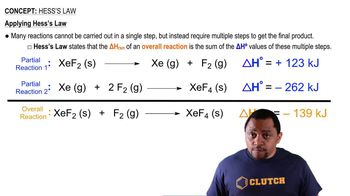Here are the essential concepts you must grasp in order to answer the question correctly.
Enthalpy of Formation
The standard enthalpy of formation (ΔH°f) is the change in enthalpy when one mole of a compound is formed from its elements in their standard states. It is a crucial value used in thermodynamics to calculate the heat changes in chemical reactions. Each substance has a specific ΔH°f, which can be found in tables, and is essential for determining the overall enthalpy change of a reaction.
Recommended video:
Hess's Law
Hess's Law states that the total enthalpy change for a reaction is the same, regardless of the number of steps taken to achieve the reaction. This principle allows for the calculation of ΔH°rxn by summing the enthalpy changes of individual steps, using the standard enthalpies of formation of reactants and products. It emphasizes the state function nature of enthalpy, making it independent of the pathway taken.
Recommended video:
Reaction Stoichiometry
Reaction stoichiometry involves the quantitative relationships between reactants and products in a chemical reaction, as represented by the balanced chemical equation. Understanding stoichiometry is essential for calculating the enthalpy change (ΔH°rxn) because it dictates the molar ratios of substances involved. Accurate stoichiometric coefficients ensure that the correct amounts of ΔH°f values are used in the calculations.
Recommended video:




